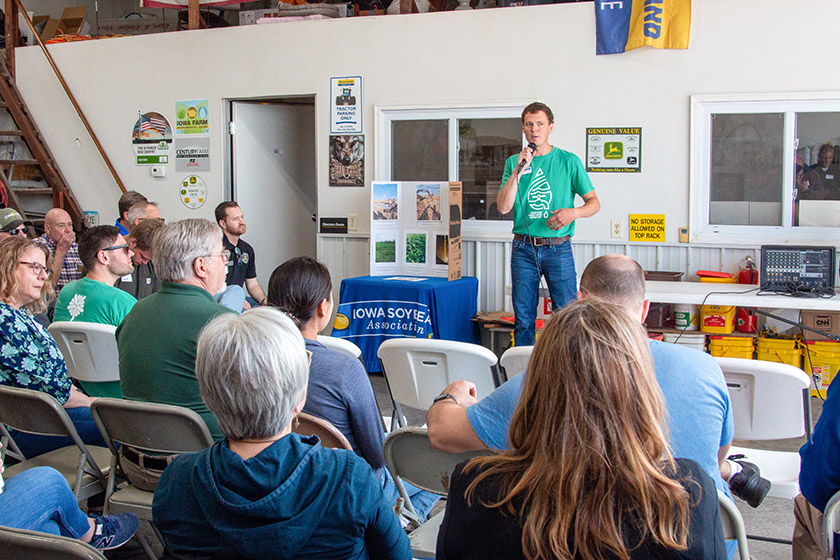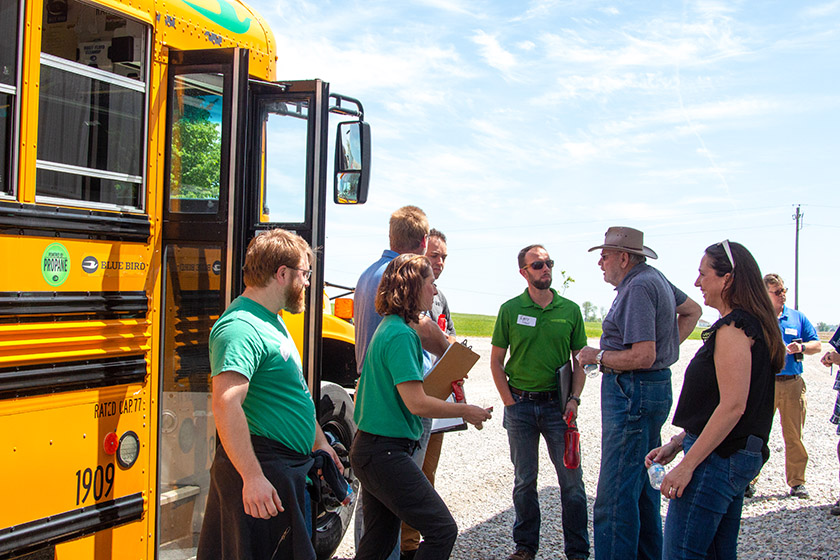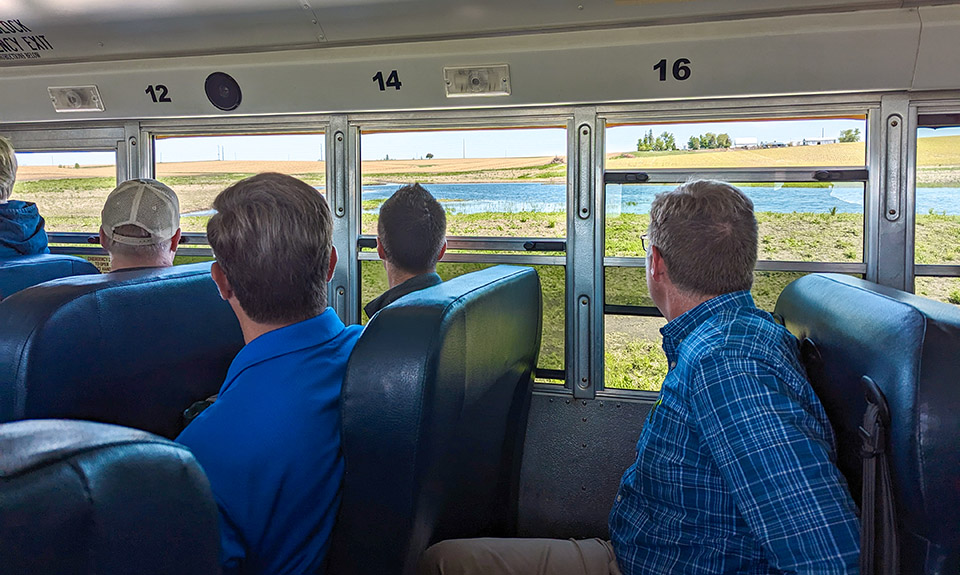
(Photo: Rebekah Jones, Iowa Agriculture Water Alliance )
Nutrient Reduction Strategy collaboration highlighted
May 25, 2023 | Jeff Hutton
Achieving clean water in Iowa must be a collaborative effort. Cities, farmers and rural communities, industries, non-profits and the private sector all have a role in making sure water resources are protected and sustainable.
That was part of the message last week during the third of a series of field days highlighting the 10th anniversary of the Nutrient Reduction Strategy in the state, organized by the Iowa Agriculture Water Alliance (IAWA), the Iowa Soybean Association (ISA) and other entities. The event highlighted the work of the Cedar River Source Water Partnership (CRSWP) and the efforts to protect water resources in the city of Cedar Rapids, as well as emphasizing the conservation practices of area farmers that directly impact the Cedar River Watershed.
“We know that water and water quality are absolutely essential ingredients to keep Cedar Rapids growing and prosperous,” says Cedar Rapids City Manager Jeff Pomeranz. “The city of Cedar Rapids is proud of our clean, safe drinking water and, proud of delivering that water to our citizens and industries.”
To do that, the city, along with multiple partners, established the CRSWP – a $16 million project funded by the U.S. Department of Agriculture-Natural Resources Conservation Service (USDA-NRCS) and 13 partners dedicated to improving water quality across Iowa.
The project is funded through the USDA-NRCS Regional Conservation Partnership Program (RCPP), which supports coordination of NRCS conservation activities to expand its collective ability to address on-farm, watershed and regional natural resource concerns.
“We know we cannot do it alone,” Pomeranz says. “Watershed investment is so important. Much of our economy is based on agriculture which requires healthy soil and clean water.”
Considering Cedar Rapids is the largest corn processing city in the world, partnering with agricultural interests in safeguarding water is a no-brainer, Pomeranz says.
“Agriculture fuels so much of our economy,” he says. “Sometimes we hear about lawsuits and litigation, all kinds of friction and consternation between government and agriculture. In Cedar Rapids, we have chosen the route of collaboration, supporting our key industries.”
That collaboration is not lost on IAWA Executive Director Sean McMahon.
He says partnerships like the one between Cedar Rapids, IAWA, ISA, the Iowa Corn Growers Association, the Iowa Pork Producers Association and more have led to significant gains in nutrient reduction losses.
“So much progress has been made,” McMahon says, pointing to farmer-led efforts like no-till/strip till, the establishment of bioreactors and saturated buffers, prairie strips, wetland creation and restoration, and the use of cover crops.
In 2009, roughly 10,000 acres of Iowa farmland implemented cover crops. That number increased to 50,000 acres at the start of the Nutrient Reduction Strategy and as of 2023, roughly 3 million acres of Iowa farmland facilitates cover crops.
“I call that progress,” McMahon says. “But we’re not going to rest until we have 12-17 million acres.”
McMahon says efforts by the CRSWP showcase the progress that is being made through the strategy.
“The Cedar River Watershed has the most public-private engagement of any in the country,” he says. “This partnership helps us reach the middle adopter and late adopter.”
Along with the 3 million acres implementing cover crops in Iowa, there are other conservations efforts in the state that continue to benefit soil and water, both on the farm and downstream to cities like Cedar Rapids.
Farmers in Iowa currently engage in no-till farming across 9.5 million acres. An additional 5.25 million acres highlight conservation tillage farming practices.
“And we are going to have even more progress in the next decade,” McMahon says. “The best is yet to come.”

Conservation is key
Part of Cedar Rapids’ success is the work in and around the city, particularly the conservation efforts by area farmers in the Cedar River Watershed.
During last week’s event, attendees were offered a tour of the area, where they saw the recent establishment of an 8.6-acre wetland.
Two area farmers, Jim O'Connell and Dan Voss, provided attendees an opportunity to see conservation practices up close.
O’Connell and Voss, say establishing these practices not only benefits their farms, but is good for the city of Cedar Rapids and other downstream communities. More importantly, they say, it's good for the overall environment.
O’Connell has been planting cover crops for more than a decade.
“Ten years ago, driving to Ames I noticed the ditches were full of dirt,” he said. “I thought, ‘What can we do to prevent that?’ We started implementing cover crops on our farm.”
O’Connell began implementing cover crops on 80 acres of corn and soybeans.
“It ended up being incredible,” he says. “Every acre that I farm now I have cover crops on. We’ll put it on in the middle of the night if we have to, but we’ll get on it during harvest. You can do it if you want. I don’t want to push it on anybody, but I don’t like that excuse that ‘I don’t have time to do it.’”
O’Connell says cover crops have been a boon for weed suppression and his herbicide bill is significantly lower.
“My chemical cost has dropped by one-third, and I foresee it going lower,” he says. “I’m not putting as much (herbicide) out there. But it takes time. It’s different management.”
In addition to the cover crops, O’Connell partnered with the USDA-NRCS to establish the 8.6-acre wetland on his property that helps to capture and clean runoff before it can drain into Morgan Creek, a tributary to the Cedar River.
“A lot of our land drains where a creek is just starting. I thought that’s a good place to put a wetland,” he says. “We are trying to do things to help. We want clean water, too. We’re drinking it. A lot of our wells are right there.”
According to Iowa State University, this wetland is expected to remove an estimated 40-90% of nitrates from area cropland drainage waters.
The wetland has been four years in the making – from 2019 when the plan was initiated, to 2021 when conservation easements were established, to the summer of 2022 when construction of the wetland began and later completed. This past February, O’Connell frost seeded the wetland site and today nitrate losses have been reduced.
He is not alone in his efforts; Voss has also implemented numerous conservation practices on his farm.
Along with no-till farming since 1988 and the use of cover crops since 2013, Voss has established edge-of-field practices including a bioreactor, saturated buffer and pollinator strips.
“There’s always new wrinkles in farming, no matter how long you’ve been farming,” he says. “Besides the people in Iowa, the most important thing is soil and water. Once the soil is gone, you don’t get it back. This is a societal issue. It’s not just a farm issue.”

‘Figured it out’
“These two farmers, for over 10 years, have figured it out,” says Evan Brehm, ISA conservation agronomist in the eastern Iowa area. “They’ve shown that conservation can pay, provide a return on investment.”
Farmers, he says, who initiate conservation practices like cover crops, no-till/strip till, field-of-edge efforts, bioreactors, saturated buffers and pollinator strips, make long-lasting impacts on soil and water.
“They see the agronomic benefits,” says Brehm.
Both McMahon and Brehm say while there is plenty of work left to do to reduce nitrogen loss and improve water quality, many Iowa farmers like Voss and O’Connell have shown the efforts can pay off.
And they’re not alone – ag retailers agree.
Thomas Fawcett, the director of environmental resources and precision ag for Heartland Co-op, and the current treasurer of Agriculture’s Clean Water Alliance, says ag retailers like Heartland are also stepping up and making a difference.
Over the past two years, the cooperative has helped nearly 400 farmers with their conservation plans, establishing more than 50,000 acres of cover crops as well as working on numerous bioreactors saturated buffers.
“What we’ve found is that through a ‘boots on the ground’ approach through conservation agronomy, we’re able to bridge a gap that had been there in the past,” he says.
Matt Becker, assistant general manager with Linn Co-op, is also a big proponent of these conservation changes that impact water quality and help farmers’ bottom line.
“Whatever we can do to make our customers profitable is good for us,” he says. “Cover crops, reduced tillage, just trying to build up that soil health.”
Looking forward to the future
Mary Beth Stevenson, the watersheds and source water program manager for the city of Cedar Rapids, says she is proud of the contributions the city and its partners have made toward the Iowa Nutrient Reduction Strategy.
“We couldn’t do the work we are doing today without our partners,” she says. “A ton of conservation practices have been adopted.”
Stevenson says similar efforts throughout Iowa must continue.
“We need to truly blanket the land in these types of practices,” she says. “By managing soil health, improving nutrient management, capturing nitrates out of the tile outlets, establishing wetlands, edge-of-field practices – all of these things – this is what our landscape could look like in the future.”
To learn more about the collaboration between upstream and downstream partners, watch this video.
Back